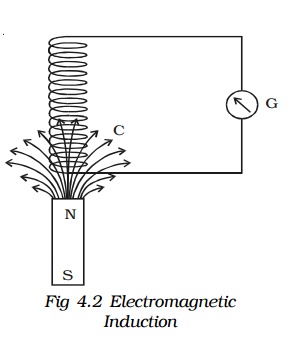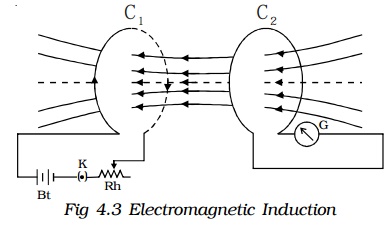Chapter: Physics : Effects of electric current : Higher Secondary(12 Std)
Induced emf and current - Electromagnetic induction
Induced emf and current – Electromagnetic induction.
Whenever there is a change in the magnetic flux linked with a closed circuit an emf is produced. This emf is known as the induced emf and the current that flows in the closed circuit is called induced current. The phenomenon of producing an induced emf due to the changes in the magnetic flux associated with a closed circuit is known as electromagnetic induction.

Faraday discovered the electromagnetic induction by conducting several experiments.
Fig 4.2 consists of a cylindrical coil C made up of several turns of insulated copper wire connected in series to a sensitive galvanometer G. A strong bar magnet NS with its north pole pointing towards the coil is moved up and down. The following inferences were made by Faraday.
(i) Whenever there is a relative motion between the coil and the magnet, the galvanometer shows deflection indicating the flow of induced current.
(ii) The deflection is momentary. It lasts so long as there is relative motion between the coil and the magnet.
(iii) The direction of the flow of current changes if the magnet is moved towards and withdrawn from it.
(iv) The deflection is more when the magnet is moved faster, and less when the magnet is moved slowly.
(v) However, on reversing the magnet (i.e) south pole pointing towards the coil, same results are obtained, but current flows in the opposite direction.

Faraday demonstrated the electromagnetic induction by another experiment also.
Fig 4.3 shows two coils C1 and C2 placed close to each other.
The coil C1 is connected to a battery Bt through a key K and a rheostat. Coil C2 is connected to a sensitive galvanometer G and kept close to C1. When the key K is pressed, the galvanometer connected with the coil C2 shows a sudden momentary deflection. This indicates that a current is induced in coil C2. This is because when the current in C1 increases from zero to a certain steady value, the magnetic flux linked with the coil C1 increases. Hence, the magnetic flux linked with the coil C2 also increases. This causes the deflection in the galvanometer.
On releasing K, the galvanometer shows deflection in the opposite direction. This indicates that a current is again induced in the coil C2. This is because when the current in C1 decreases from maximum to zero value, the magnetic flux linked with the coil C1 decreases. Hence, the magnetic flux linked with the coil C2 also decreases. This causes the deflection in the galvanometer in the opposite direction.
Related Topics